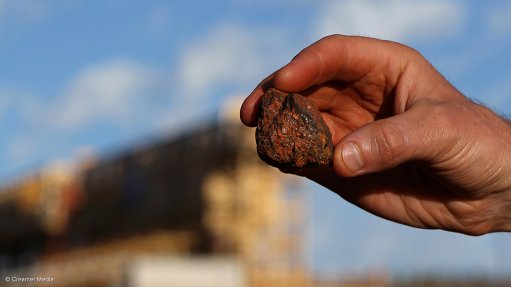
Photo by: Bloomberg
TORONTO (miningweekly.com) – In response to weak market conditions, seasonal iron-ore miner Labrador Iron Mines (LIM) had been forced to take hard decisions this year, among which was whether or not to mine any material, while exploring ways to fund its continued growth.
The TSX-listed miner with a portfolio of assets in the Labrador Trough of Atlantic Canada, chose to preserve the long-term future of its iron-ore operations, focusing this year on development activities, rather than mining the tired James mine.
However, the company early this year revealed that despite having achieved its 1.7-million in iron-ore sales guidance for 2013, the ore sold was lower in value than in previous years owing to lower grade and a higher-silica content, resulting in an operating cash shortfall of about C$30-million without which it was unable to restart mining during the 2014 season.
“To survive and ultimately prosper in today's economic environment, LIM needs to ‘reset’ its projects,” chairperson and CEO John Kearney told investors during the firm’s annual general meeting (AGM) in Toronto.
The company's direct-shipping operations (DSO) usually run from April through November, with a planned winter closure from December to March.
Kearney explained that LIM's DSO projects were conceived and developed in 2010 and 2011 in a much higher price environment than today. For example, when LIM signed some of its supply contracts in March 2011, the price of iron-ore was $194/t on a cost-and-freight China basis. Since January, the spot price of iron-ore had fallen 40% to almost $80/t today.
Kearney noted that LIM was undergoing a strategic shift in corporate focus and priorities. This included the development of the Houston mine and seeking more capital investment and working capital.
“In response to the prevailing iron-ore price outlook and based on our experience over the past three operating seasons, we have made a strategic shift in corporate focus towards establishing a lower-cost operating framework, while concurrently renegotiating the commercial terms of major contracts,” he pointed out.
Kearney believed that operating-cost saving initiatives were achievable across the board, including lowering mining costs, rail transportation, fuel procurement, aviation services, hydroelectric power, human resources and man power, and corporate and administration costs.
REFINANCING
As at June 30, LIM had a significant working capital deficit and the company would need to secure additional financial resources to address its current working capital deficit and fund its planned business objectives. Kearney said operational and financial restructuring and refinancing were required.
LIM stated that it was currently negotiating certain financing opportunities and that it was continually evaluating the current situation regarding the iron-ore price and the timing and conditions associated with potential financing proposals.
However, there were no assurances that LIM will be successful in obtaining any required financing, or in obtaining financing on a timely basis or on reasonable or acceptable terms, without which, the company would be required to curtail all operations and development activities. LIM did not say until when the company would be able to hold out, should nothing happen.
Nevertheless, Kearney was upbeat about economic growth in China, which was expected to continue unabated, even if from time to time China took “its foot off the gas pedal to avoid overheating”. This continuing growth in demand, coupled with the expected flat supply position by 2016/17, augured well for a return in the supply/demand dynamic to a balanced situation, similar to that prevailing throughout 2013, when iron-ore prices averaged around $130/t.
Kearney also pointed out the need for an overall restructure of the iron-ore business in the Labrador Trough, saying that despite advanced infrastructure being available to mine operators, the costs of electricity and ore transport remained uncompetitively high when, for example, compared with rival exporter Australia.
PROJECT FOCUS
LIM planned for the Houston mine, subject to completing financing, to be in a position to start production in 2015.
The company was also focusing on negotiating the commercial terms of major contracts, seeking more capital investment and working capital.
The company reported that it was nearing the end of a $5-million “positive” drilling campaign at its Howse exploration project.
It was also carrying out the expansion of the Silver Yards rail siding, which was the only capital project the company undertook this year. The project was fully funded by offtake partner Tata Steel Minerals Canada.
Meanwhile, LIM also reported that it was preparing an internal concept study for the Elizabeth taconite project.
“Elizabeth represents an exceptional opportunity to develop a major new concentrate operation in the Schefferville region of the Labrador Trough. There are clear competitive and cost advantages for the Elizabeth project, which include direct access to existing roads, a nail bed and power line corridor, in addition to LIM's existing infrastructure at Silver Yards,” Kearney noted.
The company’s internal concept study was using the 620-million-tonne inferred resource from the Elizabeth No 1 deposit as a starting point for planning and design.
Conceptually, the Elizabeth taconite project was designed as an openpit, with a mining capacity of 18-million tonnes a year over an expected 30-year mine life. While still in an internal preliminary assessment stage, the Elizabeth project appeared to be attractive when compared with similar taconite projects in the Labrador Trough, LIM commented.
Theoretically, over the life-of-mine, total output from Elizabeth could be about 170-million tonnes, which equated to about five-million tonnes of iron-ore concentrate a year.
During the AGM, all of the director nominees were unanimously re-elected, including Kearney, William Hooley, Matthew Coon Come, Eric Cunningham, Gerry Gauthier and Danesh Varma.